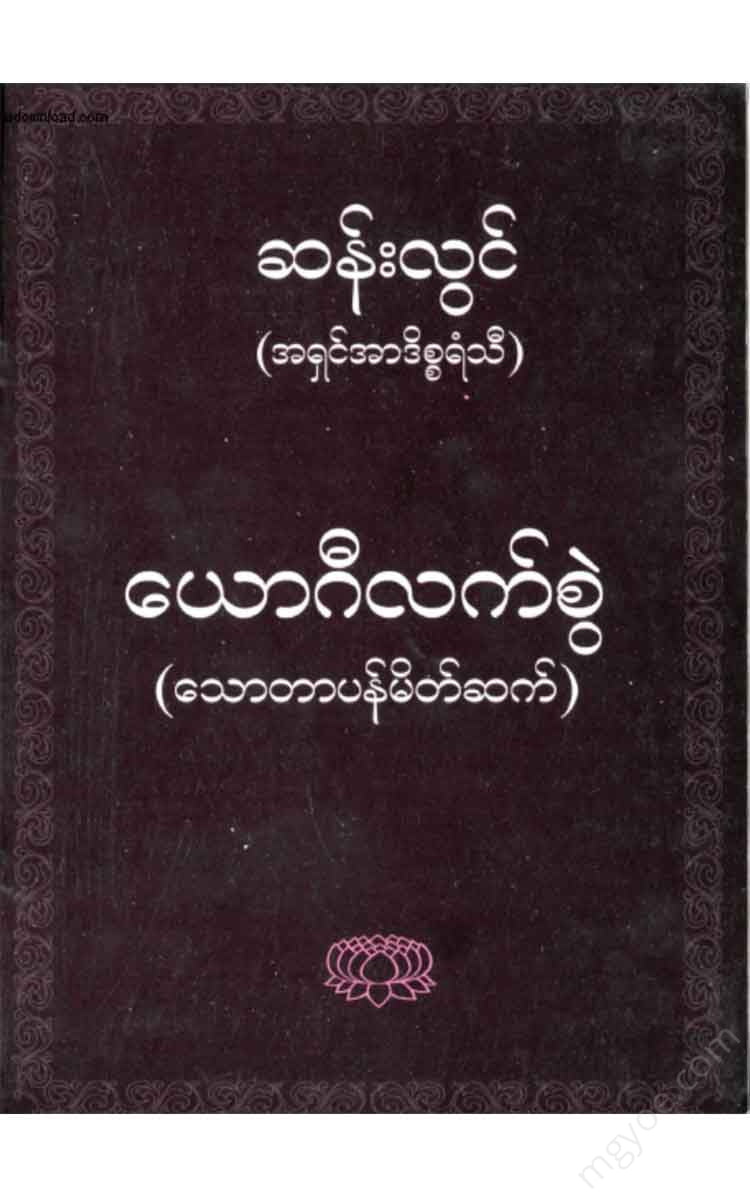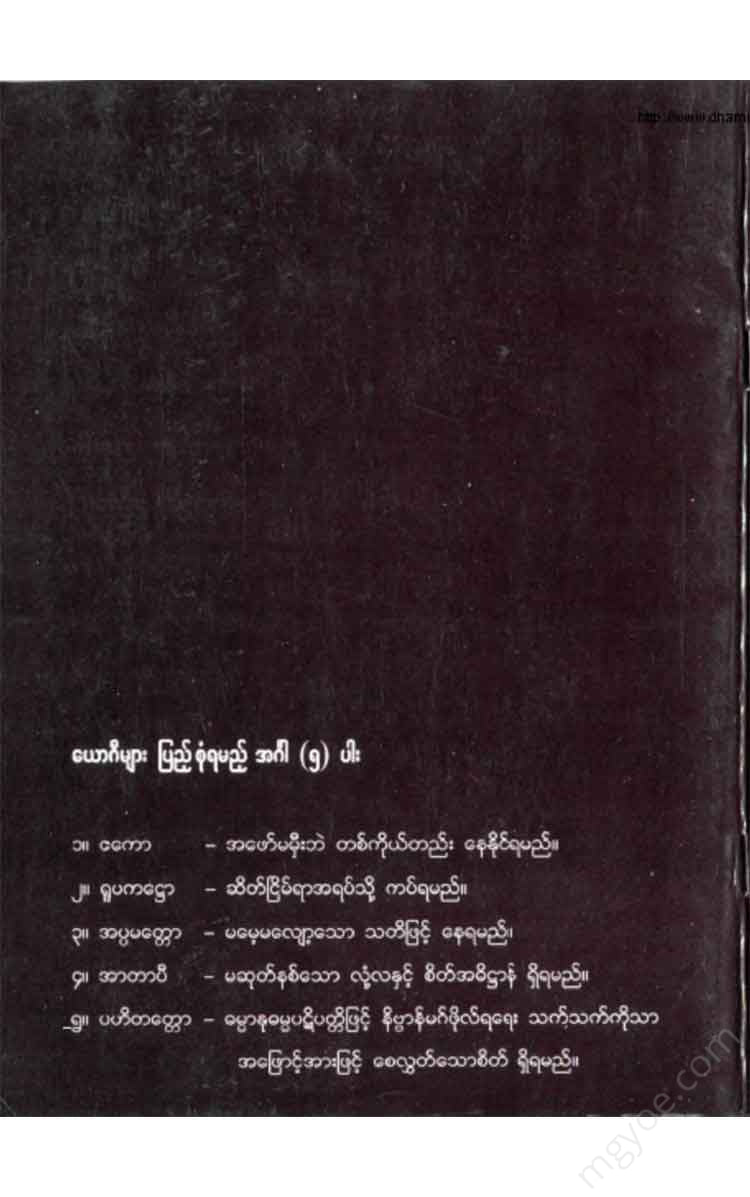Other Websites
San Lwin - Yogi's Manual (Introduction to Sotapan)
San Lwin - Yogi's Manual (Introduction to Sotapan)
Couldn't load pickup availability
San Lwin (Shin Adisaramthi)
(1938-2002)
Born on Sunday, January 13, 1938, in Thandwe, Rakhine State, to U Pho Nyunt and Daw Hla Gyi, his real name was U San Lwin. He graduated with a Bachelor of Arts (Honours) in Philosophy in 1962. After completing his Master of Arts degree, he worked as a lecturer at Myitkyina College and Yangon University.
At the age of 18, he converted from his parents' traditional Islam to Christianity, but he did not like it and abandoned Christianity after four years.
At the age of 22, he studied communism, abandoned religious beliefs, and studied various world philosophies and religions.
At the age of 32, he was assigned by his professor to compile a book on Buddhist ethics. Since he began studying world Buddhism at the Kaba Aye Buddhist University, he was delighted to find the truth he had been searching for and completed the Three Pitakas (Burmese translation).
In 1972, he left the university and became a film director. He directed the films ' Myanmar, My Mother, My Brother ', ' The World Will Be Decorated ' and ' Manaw Hari '. He also wrote the screenplays for the films 'My Brother, My Mother', ' Lakwe Moe Naeng ' and 'Mathenu's Story'. He compiled the ' Film Art and Film Technology Book ' under the name San Lwin. The translated novel 'Gambler ' won the 1968 National Literary Award for Translation Literature.
His books include Reply to the Venerable Chairman and Reply to the Golden Peacock, Philosophy of the Great Khagwe, Great Thinkers of the World, Einstein, Bertrand Russell, Great Chinese Thinkers, Great Russian Thinkers, Thought Articles on Finding Peace in the Dharma, The Spy at the Top, The Philosophy of Climbing the Golden Mountain, About a Man Who Believed in and Devoted to the Three Jewels, The Philosophy of the Awakening of True Knowledge, The Philosophy of Death, Goldstein's Personal Vipassana (co-authored with U Han Htay), Mogok's Vipassana Meditation Technique, Opening the Foundations of Theravada, The Philosophy of the Common Way of Life, Buddhist Knowledge, Advanced Understanding of Theravada Basic Concepts, Buddha's Personality Development, Dhamma Philosophy Collection, etc. He also wrote and edited a complete book under the name of University Aung Hsu. He served as the editor-in-chief of International Magazine and Dhamma Ruikwon Magazine.
At the age of 58, he was ordained as a monk in Dhammasari Monastery, Shwe Pin Win Ward, Poe Thaung Village, Bago Region, and opened the Shwe Min Win International Vipassana Meditation Center. He passed away at 10:10 PM on November 26, 2002 (Tuesday).
Namo-tassa, the forest of the Blessed One, the forest of the Arahant, the true and perfect Buddha.
Yogi's hand
Yogi What is a Yogi?
A person who is skilled in Vipassana meditation. It can be generally understood as “one who practices the Dhamma.” Here, we should understand the meaning of the word “to produce energy.” “Energy” means energy. Here, it refers to both physical (body) energy and spiritual energy (mind). “To produce” means to cause to emerge. Therefore,
A yogi should know that he is practicing the Dhamma by developing the physical and mental powers that are in harmony with the Dhamma.
In terms of “effort,” a yogi must primarily have a strong desire to exert himself. He must have a strong determination to do whatever it takes to achieve the Dharma. He must also have the unwavering determination to work tirelessly, to the point of exhaustion.
The elements of a yogi are (1) Eka - The yogi should live alone without any companion. (2) Rupak - He should approach a quiet place. (3) Appamadava - He should always keep his "mindfulness" fixed so that he does not forget. (4) Atapi - He should have unwavering zeal. (5) Pahitatta - The yogi's mind should always be directed towards the attainment of the path of Nibbana.
(Note: I will always keep in mind that I came to meditate to save myself, not to talk, not to make friends, not to make business, not to have fun.)
The goal of the meditator
A meditator must have a goal. He must have a desire. He must have a goal in life. At the beginning of his effort, the yogi must understand his life as “blind.” This means a person who is blind in mind. A blind person, a person who is blind in mind, is someone who does not understand the truth of human life. He does not yet have the true eye of wisdom to know the truth of life. Therefore, the yogi must first set the intention to change his blind life into one with the eye of wisdom (suttava).
Kalyana Puthujin (Sula Sotapan)
A person who is not afraid of the ghosts of the blind, who is only a one-way street in the cycle of existence, should first try to become an enlightened person, a person of merit (sula sota tapan). He should be like a student who strives to reach the higher level of knowledge from the elementary level to the intermediate level. The effort to reach that level can be accomplished by seeking a good teacher (relying on a good teacher) and listening to the Dhamma. Trying to do the Dhamma without listening to the Dhamma is a waste of time. If one knows (if one has understood) the body, the substance, the form, the nature of the body, the cessation of the body, the truth, then one can abandon the false view of self, the delusion of self, which clings to the whole being through the discernment of the mind. Form, He has distinguished between the nature of name, the nature of law, and the nature of the Supreme Being. He has understood the view of the cause and effect of the causality of form and name. If he has understood this, he has escaped from the one-way existence and has gone from the state of the blind to the state of the blessed. He has acquired the two lower knowledges of insight, namely, the knowledge of the distinction between name and form and the knowledge of the distinction between the two, and is a sotapan (a small sotapan) and is secure for one life. When he dies, he has escaped from the one-way existence.
It is important to become a great sotapan.
The yogi, while facing the great Buddha Dharma in this difficult life, should not be satisfied with being a liberated, liberated, and blessed person (Sula Sotapana) in one life. He should firmly resolve that in this life and this religion, he must at least become a true Maha Sotapana.
In Myanmar, many people are terrified when they hear the word "Sotapang". When asked why they are terrified, they say, "Because they have a strong belief that Sotapang is not a possible thing. These people are the ones who have been made to think that they are not worthy of Sotapang."
Sotapan is easy to use.
This meditation center is not a meditation center without a goal in life. It should not be a place where people are invited and spent all their time working. The yogi who comes to meditate here should firmly believe that he has come to become a sotapaan. I will present the sayings of the great sages that show that becoming a sotapaan is not a difficult task.
This is what the great Gandharan monk, Ashin Janaka Bhiwamsa, said.
If you try, you might fail.
The Mahavagga Samyot Pali says: “ When one contemplates this great truth, Tasvatiyanananda, Dhammadasamnama, Dhammapariyayam vedasahi,’ the reason for becoming a sotāpan is to deeply revere the merits of the three jewels and to purify the five precepts for laypeople. Therefore, when the nun Visakha first saw the Buddha, she became a sotāpan at the age of seven. The goddess Asannikita, the daughter of King Dhammasoka, heard the sound of a raven bird that was similar in tone to the Buddha’s voice, and without having to see the Buddha, she became a sotāpan with seven hundred concubines because of her reverent avispasadha (faith).
(Basic Law, page 539)
Sotapan survey
The venerable Mahasi Sayadaw also referred to the above-mentioned Dhamma Truth (Dhammadasa Sutta) and explained how to know that one is a Sotāpan. He explained that if one is endowed with the Dhamma of ‘Avisapasada’ (faith), which is unwavering faith in the Three Jewels, and if one has fulfilled the five precepts in one’s body, one can decide that one is a Sotāpan. He shows that there is no need to be judged by others. Furthermore, when a noble disciple who considered himself to be endowed with the Sotāpattiyanga confessed during the time of the Buddha, the venerable Sariputta praised him, saying, ‘ Dāyaka, you are worthy of teaching the fruit of the Sotāpattiyanga .’
(Vipassana Meditation (Second Edition), page 292)
Reincarnation
The Visuddhimagga clearly states this. Even if one is a “soulless person,” one can still enjoy the worldly happiness that one has attained. There is no reason for a noble person not to enjoy the fruit that one has attained. The Pali text of the Patisambida Magga directly states that the Sotapatiphala samma pannatthaya, the Sakadagamifala samma pannatthayayanappadam, the Abhibuyatiti katobu, etc., are also possible. If one is a noble person but still cannot enjoy the fruit, it can only be assumed that the concentration and the remaining faculties are not yet fully developed. One should be satisfied if one can enjoy the fruit happiness many times.
(Vipassana Meditation (Second Edition), Volume 320)
How to make a flower pot
A noble person who wishes to remain in the state of bliss should first (in the past) make a resolution, “May I remain in the state of bliss for this long period of time (whether it be an hour or half an hour),” and meditate on it. He should not strive for the sake of remaining in the state of bliss for the sake of rebirth, nor should he expect or desire it, but should simply meditate on it. While meditating, the period of time for which he has made a resolution is the time for which he has remained in the state of bliss.
The mind will remain alive and abiding only in the state of Nibbana, where all mental formations are completely extinguished and free from all mental formations, without being distracted by them.
How to focus during sexual intercourse
Idhaananda, the monk Evamsanyihoti- Asachi Gatha (Ekadassa Anguttora Pali) says: “Ananda, in this Dhamma, a monk has this kind of awareness. The awareness is this: That which is Nibbana is the cessation of all formations. It is the abandonment of all attachments. It is the cessation of craving. It is the cessation of craving. It is the cessation and disappearance of formations. This cessation, Nibbana, is peaceful. It is good. Such is the awareness.
(Vipassana Meditation (Second Edition), No. 328)
Some people, when they are reborn, quickly reach the birth place. They also quickly rise from the birth place. They come into the birth place many times through one cycle of contemplation and one cycle of contemplation. This is because they have not yet mastered the process of rebirth. During their rebirth, they hear such attention (especially) to sound. For example, when the Venerable Moggallana was reborn on the banks of the Samanaka River, he said that he heard the sound of elephants descending into the river and ascending again. But when they have attained the arahantship of the birth place, the arahantship of the eternal life, they may not even hear thunder.
(Vipassana Insight, page 333)



